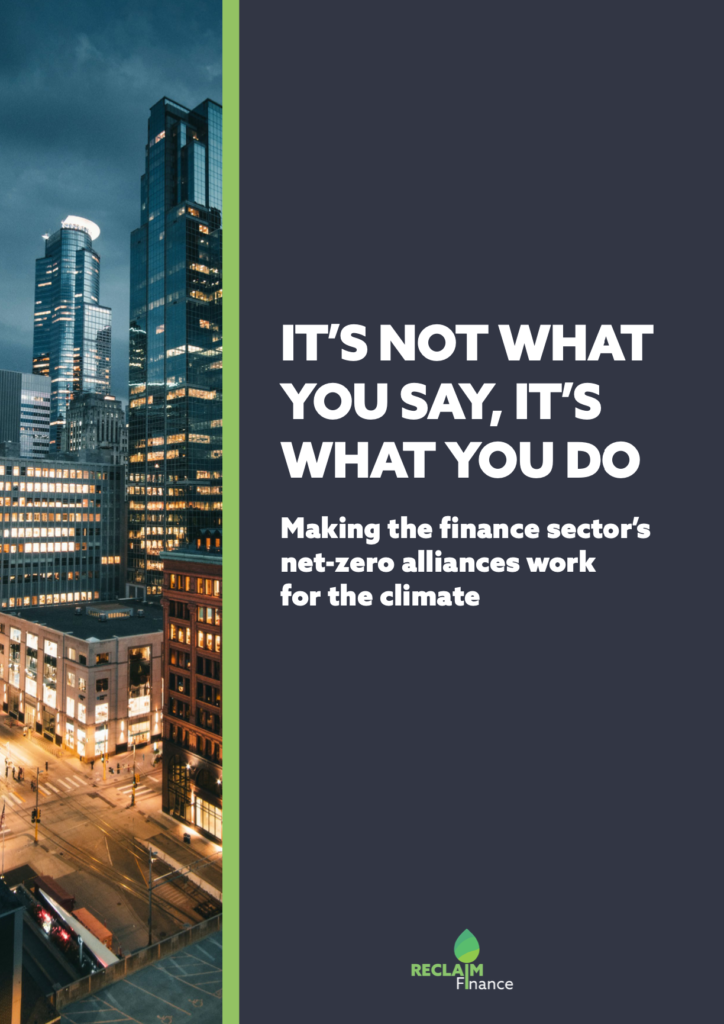Net Zero Financial Alliance Has Serious Shortcomings
At COP26 in Glasgow in November of 2021, a group of financial institutions representing $130 trillion of private capital joined a framework called the “Glasgow Financial Alliance for Net Zero” (GFANZ). The alliance is led by Mark Carney, the UN Special Envoy for Climate and Finance, and requires its members to be accredited by the UN Race to Zero campaign. The criteria for accreditation include committing to reach net-zero emissions, including both direct and indirect emissions, by 2050 at the latest. It also requires firms to set interim targets for 2030 in line with the IPCC report on 1.5°C of warming. This implies an average emissions reduction of 7% per year until 2030. Members also commit to transparent reporting and accounting of emissions reductions.
While it is an accomplishment to have secured net-zero commitments from such a large portion of the financial industry, there are serious flaws in the framework of GFANZ that will likely prevent it from achieving its goal. A November 2021 report from the NGO Reclaim Finance details the issues with the framework, including opaque processes, several loopholes, and a failure to require that members cease funding the expansion of fossil fuel infrastructure. The report’s key message is the following:
“The alliances should refocus from their current emphasis on setting economy-wide targets for the thousands of companies in their portfolios through complex, opaque, loophole-ridden, and protracted processes. Instead, the alliances need to act swiftly on the prime culprits for climate change: the major producers and consumers of fossil fuels.”
The report gives the following key findings and recommendations for GFANZ and its members to meet their net-zero commitments in line with limiting warming to 1.5°C:
A flood of net-zero alliances
- Nearly 300 financial institutions, including many of the world’s biggest investors, bankers and insurers have joined one of six sectoral net-zero alliances under the umbrella of the Glasgow Financial Alliance for Net Zero (GFANZ). Together these financial institutions have assets equal to more than a third of the world’s investable capital.
- Joining GFANZ commits the members of the alliances to complying with the criteria of the UN’s Race to Zero Campaign. This means aligning the emissions of the companies in their portfolios with the IPCC’s report on 1.5°C, which requires halving emissions by 2030 and reaching net zero by 2050.
- The Net-Zero Asset Owner Alliance is the oldest of the GFANZ entities and has produced the most comprehensive guidelines. It is the only alliance to require its members to set 2025 targets in addition to 2030 ones.
Analysis paralysis: the alliances’ approach is slow and opaque
- The alliances are failing to meet the Race to Zero’s insistence on urgency and are falling into the trap of “analysis paralysis” of which it warns.
- The alliances’ approach to target setting is based on their members calculating the “financed emissions” (or “insured emissions”) of their portfolios. This requires a complex, years-long, and opaque process that makes it difficult for outside analysts to monitor progress at meeting targets. While these approaches are needed in the longer term, they don’t replace the imperative for immediate and transparent action on the biggest polluters.
- The Net-Zero Banking Alliance allows its members three years before they have to set targets for all nine required carbon-intensive sectors and an extra year before they have to explain what actions they are taking to meet all these targets. The Net Zero Asset Managers Initiative sets no deadline before 2050 for its members to set targets across their portfolios.
The alliances’ guidelines are beset with loopholes and omissions
- The Race to Zero criteria do not mention fossil fuels, by far the single largest cause of the climate crisis.
- It is not mandatory for alliance members to reduce Scope 3 emissions from the companies they support. This is particularly problematic for the fossil fuel sector where Scope 3 emissions account for around 88% of their total emissions.
- Absolute emission targets are not required. The alliances suggest but do not require that targets are set using absolute emissions numbers, instead requiring only emission intensity metrics.
- None of the GFANZ alliances prohibit the use of offsets, or set any numerical limits on their use.
- The Asset Owner Alliance calls for an end to investments in new coal mines and power plants, but it does not require its members to act on this. As of mid-October 2021 at least 34 of the 58 AOA members lacked a policy to restrict investments in coal developers.
The alliances must focus on fossil fuels
- The only way that the alliances can respond to the urgency of the climate crisis is to reorient their efforts to a rapid wind down of financing for fossil fuels.
- The IEA has explained that staying under 1.5°C means stopping financing for fossil fuel expansion. Several of the alliances explicitly state their support for the IEA’s scenarios. They must require their members to end their support for new coal, oil and gas supply projects.
- The alliances must stop financial services for coal-heavy companies and require other companies to adopt plans that exit coal by 2030 in industrialized countries and 2040 globally.
- Financial services should only be provided to utilities with plans to phase out their gas power production by the deadlines given by the IEA: 2035 in wealthy countries and 2040 globally.
- Financial services should only be provided to oil and gas companies with plans to wind down their production between 2020 and 2030 consistent with at least the average annual rates given in the UNEP Production Gap Report: 11% for coal; 4% for oil; 3% for fossil gas.
The full report from Reclaim Finance can be found here.

